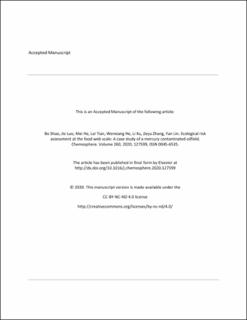| dc.contributor.author | Shao, Bo | |
| dc.contributor.author | Luo, Jie | |
| dc.contributor.author | He, Mei | |
| dc.contributor.author | Tian, Lei | |
| dc.contributor.author | He, Wenxiang | |
| dc.contributor.author | Xu, Li | |
| dc.contributor.author | Zhang, Zeyu | |
| dc.contributor.author | Lin, Yan | |
| dc.date.accessioned | 2020-12-02T10:22:24Z | |
| dc.date.available | 2020-12-02T10:22:24Z | |
| dc.date.created | 2020-09-03T11:42:58Z | |
| dc.date.issued | 2020 | |
| dc.identifier.citation | Chemosphere. 2020, 260. | en_US |
| dc.identifier.issn | 0045-6535 | |
| dc.identifier.uri | https://hdl.handle.net/11250/2711398 | |
| dc.description | Embargo until 18 July 2020 | en_US |
| dc.description.abstract | Mercury, particularly methylmercury, can accumulate through food webs and generate high risks for species at higher trophic levels. Inorganic mercury can be methylated into the organic species methylmercury if suitable reducing conditions exist, for example, in hotspots like oilfields. We developed a conceptual model to conduct an ecological risk assessment based on the food web structure of the Shengli oilfield area, China. The model can identify species at risk and elucidate the sources of risks according to their diet. A risk rating criteria was developed based on the food web structure to categorize the different levels of risks for different species. As expected, the results indicate increasing risks for the biota higher in the food web hierarchy. Grasshoppers were mostly at no risk throughout the study area, whereas grubs at southwest were at minimal risks due to local high Hg concentration in the soil. Mantises, which are insect predators, were also at minimal risk. Herbivorous birds with similar feeding habits than grasshoppers were at no risk, but omnivorous and carnivorous birds were at moderate risk. The conceptual model is a useful tool to improve pollution remediation and establish risk control strategies based on ecological risks of the food web rather than just Hg concentrations in the environment. | en_US |
| dc.language.iso | eng | en_US |
| dc.publisher | Elsevier | en_US |
| dc.rights | Attribution-NonCommercial-NoDerivatives 4.0 Internasjonal | * |
| dc.rights.uri | http://creativecommons.org/licenses/by-nc-nd/4.0/deed.no | * |
| dc.title | Ecological risk assessment at the food web scale: A case study of a mercury contaminated oilfield | en_US |
| dc.type | Peer reviewed | en_US |
| dc.type | Journal article | en_US |
| dc.description.version | acceptedVersion | en_US |
| dc.source.pagenumber | 11 | en_US |
| dc.source.volume | 260 | en_US |
| dc.source.journal | Chemosphere | en_US |
| dc.identifier.doi | 10.1016/j.chemosphere.2020.127599 | |
| dc.identifier.cristin | 1827027 | |
| dc.source.articlenumber | 127599 | en_US |
| cristin.ispublished | true | |
| cristin.fulltext | postprint | |
| cristin.qualitycode | 1 | |

